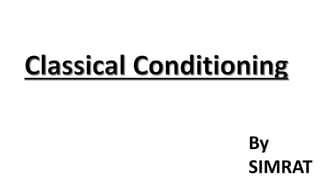Classical conditioning
•
12 gefällt mir•1,835 views
Ivan Pavlov, a Russian scientist, discovered classical conditioning while studying the digestive system of dogs. He found that dogs deprived of food would salivate when his assistant entered the room. Through further investigation, Pavlov established that a stimulus that initially produces no response can acquire the ability to produce a response through repeated pairing with another stimulus that does elicit a response. Classical conditioning involves an unconditioned stimulus, unconditioned response, conditioned stimulus, and conditioned response.
Melden
Teilen
Melden
Teilen

Empfohlen
Empfohlen
Weitere ähnliche Inhalte
Was ist angesagt?
Was ist angesagt? (20)
Operant Conditioning : Behavioral theory (B.F.SKINNER THEORY)

Operant Conditioning : Behavioral theory (B.F.SKINNER THEORY)
Ähnlich wie Classical conditioning
The Behavioural Model/ BehaviourismBehaviourism/ The Behavioural Model. By Theresa Lowry-Lehnen. Lecturer of Psy...

Behaviourism/ The Behavioural Model. By Theresa Lowry-Lehnen. Lecturer of Psy...Theresa Lowry-Lehnen
Ähnlich wie Classical conditioning (20)
Principles and Applications of Classical and operant conditioningppt.pptx

Principles and Applications of Classical and operant conditioningppt.pptx
Behaviourism/ The Behavioural Model. By Theresa Lowry-Lehnen. Lecturer of Psy...

Behaviourism/ The Behavioural Model. By Theresa Lowry-Lehnen. Lecturer of Psy...
Classical Conditioning according to Pavlov and J.b Waston 

Classical Conditioning according to Pavlov and J.b Waston
Mehr von Simrat Simrat
Mehr von Simrat Simrat (15)
Kürzlich hochgeladen
Mehran University Newsletter is a Quarterly Publication from Public Relations OfficeMehran University Newsletter Vol-X, Issue-I, 2024

Mehran University Newsletter Vol-X, Issue-I, 2024Mehran University of Engineering & Technology, Jamshoro
Kürzlich hochgeladen (20)
Sensory_Experience_and_Emotional_Resonance_in_Gabriel_Okaras_The_Piano_and_Th...

Sensory_Experience_and_Emotional_Resonance_in_Gabriel_Okaras_The_Piano_and_Th...
ICT Role in 21st Century Education & its Challenges.pptx

ICT Role in 21st Century Education & its Challenges.pptx
Kodo Millet PPT made by Ghanshyam bairwa college of Agriculture kumher bhara...

Kodo Millet PPT made by Ghanshyam bairwa college of Agriculture kumher bhara...
HMCS Vancouver Pre-Deployment Brief - May 2024 (Web Version).pptx

HMCS Vancouver Pre-Deployment Brief - May 2024 (Web Version).pptx
On National Teacher Day, meet the 2024-25 Kenan Fellows

On National Teacher Day, meet the 2024-25 Kenan Fellows
This PowerPoint helps students to consider the concept of infinity.

This PowerPoint helps students to consider the concept of infinity.
Beyond_Borders_Understanding_Anime_and_Manga_Fandom_A_Comprehensive_Audience_...

Beyond_Borders_Understanding_Anime_and_Manga_Fandom_A_Comprehensive_Audience_...
Fostering Friendships - Enhancing Social Bonds in the Classroom

Fostering Friendships - Enhancing Social Bonds in the Classroom
HMCS Max Bernays Pre-Deployment Brief (May 2024).pptx

HMCS Max Bernays Pre-Deployment Brief (May 2024).pptx
Food safety_Challenges food safety laboratories_.pdf

Food safety_Challenges food safety laboratories_.pdf
Basic Civil Engineering first year Notes- Chapter 4 Building.pptx

Basic Civil Engineering first year Notes- Chapter 4 Building.pptx
UGC NET Paper 1 Mathematical Reasoning & Aptitude.pdf

UGC NET Paper 1 Mathematical Reasoning & Aptitude.pdf
Classical conditioning
- 1. By SIMRAT
- 2. --Born Sept 14, 1849 --Died Feb 27, 1936 --Born in Russia --Physiologist, psychologist, and physician --Awarded the Nobel Prize in Physiology or Medicine in 1904 for research on the digestive system
- 3. Classical conditioning was the first type of learning to be discovered and studied within the behaviorist tradition. Conditioning is a kind of response build up through repeated exposure. The major theorist in the development of classical conditioning is Ivan Pavlov, a Russian scientist trained in biology and medicine . Pavlov was studying the digestive system of dogs and became intrigued with his observation that dogs deprived of food began to salivate when one of his assistants walked into the room. He began to investigate this phenomena and established the laws of classical conditioning
- 4. Conditioning -- a stimulus that initially produces no response can acquire the ability to produce one. Learning occurs through pairing in time and place of one stimulus with another stimulus that produces a response. This is a kind of associative shifting, but the response is involuntary. The classical conditioning theory is based on the assumption that learning is developed through the interactions with the environment. Also, the environment shapes the behavior and internal mental state such as thoughts, feelings, emotions do not explain the human behavior.
- 8. An organism learns to transfer response from one stimulus to a previously neutral stimulus. Classical conditioning is comprised of four elements: Unconditioned Stimulus (US): Which invariably causes to react in a way. Unconditioned Response (UR): Takes place when the US is presented. Conditioned Stimulus (CS): The object that does not bring about the desired response Conditioned Response (CR): a particular behavior that an organism learns to produce, when the CS is presented.
- 9. Classical conditioning (also known as Pavlovian or respondent conditioning) refers to a learning procedure in which a biologically potent stimulus (e.g. food) is paired with a previously neutral stimulus (e.g. a bell). It also refers to the learning process that results from this pairing, through which the neutral stimulus comes to elicit a response (e.g. salivation) that is usually similar to the one elicited by the potent stimulus.
- 10. Acquisition – This is the initial stage of learning when a response is first established and gradually strengthened. A neutral stimulus is repeatedly paired with an unconditioned stimulus to get a conditioned response. Stimulus generalization – stimuli like the CS become able to evoke the conditioned response. Extinction – if the UCS and CS are not paired, the CS loses its ability to produce a conditioned response. Spontaneous recovery – an extinguished CS briefly returns but quickly goes away again.
- 11. Figure 8.4 Acquisition, Extinction, and Spontaneous Recovery. Acquisition: The CS and the US are repeatedly paired together and behaviour increases. Extinction: The CS is repeatedly presented alone, and the behaviour slowly decreases. Spontaneous recovery: After a pause, when the CS is again presented alone, the behaviour may again occur and then again show extinction.
- 12. • Fear, love towards a particular subject is created through conditioning. • A teacher, method of teaching or harsh treatment of his students, create strong dislike among them towards subject. • The theory of classical conditioning emphasizes that the students should be exposed to positive stimuli in order to develop desirable habits, interest and attitudes in them.
